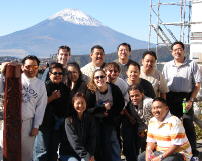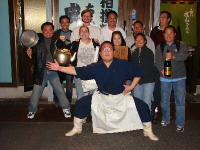
What first might be mistaken for a super-sized black jelly bean is actually an egg. No, this is not a "goth" themed Easter egg blog posting. This my friends is the story of the legendary black eggs of Hakone! Well maybe not legendary, but they certainly are black. Brad or Timmy (Sorry, wasn't sure who) proudly shows off his black egg for the camera before chowing down on this unusual food item.

We happened upon these eggs while touring Owakudani. (Look for my earlier posting about our visit to Owakudani.) These black eggs start off as normal chicken eggs until they are cooked. What gives them their distinctive black color is the sulfuric water that they are boiled in. I am told that the hydrogen sulfide that is present in the sulfur pits react with the iron in the eggs causing them to turn that deep black color. Don't be fooled by the scary exterior though, crack one open and they look and taste just like a hard boiled chicken egg.

Eating one of these eggs is supposed to add seven years to your life. (So does that mean if I eat ten eggs I will live to be over 100?) It's hard to believe that anything cooked in that milky blue-green foul smelling water could be good for your health. It makes you wonder if the people who cook them have any health issues since they must be inhaling these sulphurous fumes all day as they cook the eggs. Now tell me, does that water look healthy to you?









